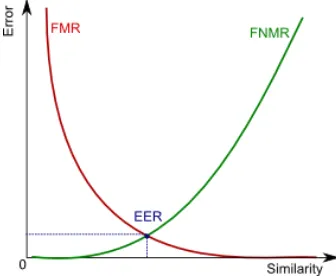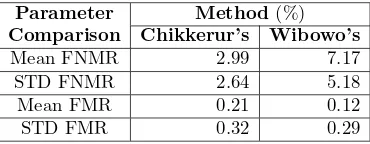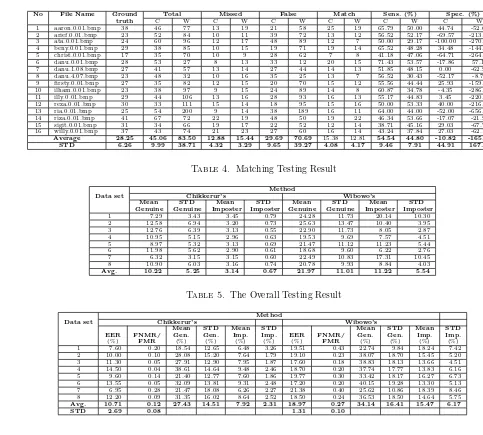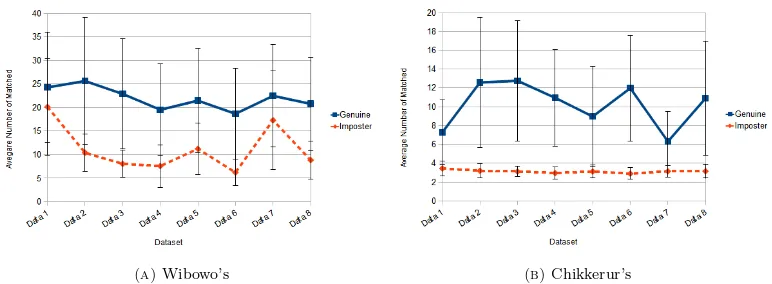Computer, Graph and Combinatorics, pp.601–614.
A Comparison Framework for
Fingerprint Recognition Methods
Ary Noviyanto and Reza Pulungan
Abstract.Many fingerprint recognition methods have been proposed and the need arises for a methodology to compare these methods, in order to be able to decide whether a
particular method is better than another. In this paper, we report on our effort to develop a methodology to compare the robustness of fingerprint recognition methods. As
a case study, we apply this methodology to compare two recent fingerprint recognition
algorithms proposed by Chikkerur (2005) and Wibowo (2006). We are able to conclude
that, overall, Chikkerur’s algorithm performs better than Wibowo’s.
Keywords and Phrases: Fingerprint recognition methods, comparison framework.
1. INTRODUCTION
The needs for biometrics that can be used to recognize people based on their bodily characteristics have existed long. Biometric recognition is associated with identification (“Who is X?”) and verification (“Is this X?”) [13]. Alphonse Bertillon, chief of the criminal identification division of the police department in Paris, conceived an idea that body measurements can be used to identify criminals; and this has changed major law enforcement departments in the mid-19th century [3].
Not all body measurements can be eligible to be a biometric. Human fingerprint, which has been used for authentication purposes for more than 100 years [3, 4, 7], is one of the most well-known biometrics. Fingerprints can be a biometric because they have characteristics that are feasible to measure, distinct, permanent, accurate, reliable, and acceptable [7]. There are three levels of fingerprints’ features that can be used in recognition processes [5]:
(1) Global level: the ridge flows of fingerprints create particular patterns, such as shown in Figure 1.
2010 Mathematics Subject Classification: 68T10
(2) Local level: there are 150 different patterns or forms of ridges in fingerprints. These patterns are called minutiae (see Figure 2). The most popular minutiae areridge endingsandridge bifurcations.
(3) Very-fine level: at this level, we look at the deeper levels of detail in the ridges. The most important feature is finger sweet pore, which can be observed using a high resolution sensor (1000 dpi) (see Figure 2).
(a) (b) (c) (d) (e)
Figure 1. Global level of fingerprints’ features [5]: (A) Left-loop, (B) Right-loop, (C) Whorl, (D) Arch, and (E) Tented-arch
Figure 2. Black solid circles areminutiae and circles with hole are sweat pore [5]
2. PRELIMINARIES
2.1. Failures in Biometric System. There are two possible errors in biometric sys-tems [2], namely:
(1) α-error, which is a failure occurring when comparison results reject or conclude as different, things which are the same. Hence, this is also called a false non-match. The ratio of this failure is calledfalse non-match rate(FNMR) orfalse reject rate(FRR).
(2) β-error, which is a failure occurring when comparison results accept or conclude as the same, things which are different. Hence, this is also called afalse match. The ratio of this failure is called false match rate(FMR) or false accept rate (FAR).
2.2. False Non-Match (FNM) and False Match (FM). In order to define FNM and FM, we first define feature extraction, matching and the process of making con-clusions. We define a sample of biometrics as Sik; where iis the individual that the
biometric sample belongs to andkdenotes the index of the successful acquisition pro-cess (different samples of biometrics can be acquired from the same individual). The features of every biometric sampleSik, denoted byXik, is then extracted. The result
of matching, denoted byYik,i0k0, is obtained from matching biometric samplesSik and Si0k0. The next process is to decide whether the two biometric samples represent the same biometric. Given a thresholdτ, two biometrics are not similar ifYik,i0k0 >τ and two biometrics are similar ifYik,i0k0 τ.
We defineDii0j, a binary function that represent the j-th conclusion taken from comparing the biometrics of thei-th andi0-th individuals. If the value ofD
ii0j is one, then the sistem has made a mistake and if the value ofDii0l is zero, then the sistem was right. Dii0lis defined as follows:
Dii0j=
FromDii0kwe can compute False Non-Match Rate (FNMR) dan False Non-Match Rate (FMR) as follows:
wherenii0is the number of comparisons between two individuals, andniiis the number
of time an individual is compared with himself. Ifi=i0 then the comparison is called
2.3. Sensitivity and Specificity. Sensitivityandspecificityare used to measure the success of an algorithm in detectingminutiae[8]. They are defined as follows:
Sensitivity = 1 missedminutiae
groundtruth , and (4)
Specificity = 1 falseminutiae
groundtruth, (5)
where missedminutiae is the number of genuineminutiaethat are not detected, falseminutiae is the number of falseminutiaethat are detected, and groundtruth is number ofminutiae that are defined by fingerprint experts.
2.4. Equal Error Rate (ERR). Equal Error Rate(ERR) is an objective evaluating criteria for classifier performance testings. It is objective in the sense that the rejection threshold is selected independently. Equal Error Rate defines the intersection point between FNMR and FMR curves as the function of the rejection threshold [6]. In other words, ERR is a value where FNMR is equal to FMR, as shown in Figure 3.
Figure 3. The Relationship between FNMR, FMR and ERR
2.5. Mean and Standard Deviation. Meanis used to assert the common value from a collection of values. The mean ofN dataXi, denoted by ¯X, is defined by [9]:
¯ X=
PN
i=1Xi
N . (6)
Beside mean, we need a way to measure the spread of the collection of values from its means. Standard deviationofN dataXi, denoted bys, is defined by [9]:
s= s
PN
i=1(Xi X)¯ 2
3. THE COMPARISON FRAMEWORK
We divide the whole fingerprint recognition process into three parts, namely en-hancement process, feature extraction process and matching process. To get a complete view of the quality of two fingerprint recognition methods or more, we need to com-pare the three parts separately. The results of the partial comparisons will inform us about the relative quality of the given fingerprint recognition methods. We therefore de-fine a comparison framework that contains testings for each part, namely enhancement testing, feature extraction testing, and matching testing.
3.1. Enhancement Testing. The enhancement testing is a testing that comparesonly the enhancement process of fingerprint recognition methods. The aim of this testing is to compare the success rate of each enhancement process. Figure 4 shows how enhancement testings are carried out. To fairly compare the quality of enhancement processes, we use third party softwares that do not contain any enhancement process whatsoever. We use MINDTCT [11] as feature extraction software and BOZORTH3 [10] as matcher software to perform verification. The quality of each enhancement process is then represented by its FNMR and FMR.
Figure 4. The Flow Diagram of the Enhancement Testing
3.2. Feature Extraction Testing. The feature extraction testing is a testing that comparesonly the feature extraction process of fingerprint recognition methods. The difficulty of this testing lies in that a particular feature extraction method might be linked with a particular enhancement method during analysis. Therefore, we need to pass all necessary parameters from the enhancement process to the feature extraction process, if any. We have to make sure that the image is not changed after the en-hancement process. Figure 5 shows that the enen-hancement process is retained in the testing, but filtering process that modifies the raw image is removed. With this scheme, parameters that are required during the feature extraction process can be passed on without changing the input image, and hence the input images before and after the enhancement process are the same.
create a standard template of the genuine fingerprint features, so that we can compute the values ofsensitivityandspecificityprecisely.
Figure 5. The Flow Diagram of the Feature Extraction Testing
3.3. Matching Testing. The matching testing is a testing that compares only the matching process of fingerprint recognition methods. The difficulty of this testing lies in the differences of features’ representation. A particular matcher might be related with a particular features’ representation. Therefore, features’ representations are converted to a particular format that conforms with the matchers. To compare fairly, we have to make sure that the features are the same although they might have different representations. In this testing, we compute mean and standard deviation of matched feature points (minutiae) ingenuine matchingandimposter matching. Using the combination of the values of mean and standard deviation of matched minutiae, the performance of matcher to determine fingerprint images through its features can be observed. The distance of the mean ± standard deviation between genuine matching and imposter matchingis required to determine the threshold. The greater the distance, the easier it is to determine the threshold. An overlap of the mean±standard deviation between genuine matchingandimposter matching—i.e., their mean±standard deviation inter-sect each other—means that there must have been mistakes or failures in the matching process. If such overlap exists, the threshold cannot be determined precisely.
Figure 6. The Flow Diagram of the Matching Testing
3.4. Overall Testing. Beside the partial testings (i.e., enhancement testing, feature extraction testing and matching testing), we also perform an overall testing that com-pares the whole process of fingerprint recognition methods. This testing is used to compare the evaluation results of the fingerprint recognition methods.
4. EXPERIMENTAL DATA
We collect our data set using a 500 dpi resolution fingerprint sensor that can produce images of size 280⇥360 pixels. Figure 7 shows several examples of the obtained fingerprint images. We also have a particular naming scheme: each fingerprint image is named according to format: name.fingerprint-code.index-of-acquisition.bmp.
(a) (b) (c) (d) (e)
Figure 7. Several fingerprint images in 500 dpi resolution: (A) agung.0.03.bmp, (B) ata.1.06.bmp (C) kartika.2.01.bmp, (D) christ.3.03.bmp, and (E) illy.4.01.bmp
From 16 volunteers, a total of 640 fingerprint images have been collected. From each volunteer we took 40 images; eight different images for each finger.
5. EXPERIMENTAL RESULTS
To demonstrate the use of the framework, we will use and compare the imple-mentations of two fingerprint recognition methods based on Chikkerur’s [1] and Wi-bowo’s [12].
5.1. Enhancement Testing Result. In this phase, we compare two enhancement methods: STFT analysis method [1] and Gabor filter method [12]. The result of the enhancement testing is shown in Table 1 and Table 2. Table 1 shows the comparison of FNMR and FMR of both Chikkerur’s and Wibowo’s methods for each data set. The values of the mean and the corresponding standard deviation of data in Table 1 are presented in Table 2.
Table 1. Enhancement Testing Result Data set Comparison Method(%)
Chikkerur’s Wibowo’s
Table 2. Mean and STD of FNMR and FMR from Table 1 Parameter Method(%)
as significant as that of FNMR results. Overall, we can conclude that Chikkerur’s enhancement method performs better than Wibowo’s enhancement method.
5.2. Feature Extraction Testing Result. In the second testing, we compare two fea-ture extraction methods:chain codebased method [1] andtemplatingbased method [12]. The result of feature extraction testing is shown in Table 3. The columns of Table 3 are as follows:
(1) File Nameis name of the file of the fingerprint image.
(2) Ground truthis the number of the genuine minutiae based on benchmark. (3) Totalis the total number of minutiae that can be extracted.
(a)FNMR (b)FMR
Figure 8. Enhancement testing result: (A) the values of FNMR for each data set, and (B) the values of FMR for each data set. The continuous line represents Chikkerur’s enhancement method while the dashed line Wibowo’s
(7) Sens. andSpec. are the values of sensitivity and specificity, respectively. The associated sensitivity and specificity of the two methods from Table 3 are shown in Figure 9. From Figure 9, we observe that both sensitivity and specificity of Chikkerur’s method are higher than those of Wibowo’s. This means that Chikkerur’s feature extraction method performs better than Wibowo’s features extraction method.
(a)Sensitivity (b)Specificity
Figure 9. Feature extraction result: (A) the values of sensitivity, and (B) the values of specificity. The continuous line represents Chikkerur’s enhancement method, while the dashed line represents Wibowo’s
610
No File Name Ground Total Missed False Match Sens. (%) Spec. (%)
truth C W C W C W C W C W C W
1 aaron.0.01.bmp 38 46 77 13 19 21 58 25 19 65.79 50.00 44.74 -52.63
2 arief.0.01.bmp 23 52 84 10 11 39 72 13 12 56.52 52.17 -69.57 -213.04
3 ata.0.01.bmp 24 60 96 12 17 48 89 12 7 50.00 29.17 -100.00 -270.83
4 beny.0.01.bmp 29 38 85 10 15 19 71 19 14 65.52 48.28 34.48 -144.83
5 christ.0.01.bmp 17 35 70 10 9 28 62 7 8 41.18 47.06 -64.71 -264.71
6 danu.0.01.bmp 28 53 27 8 13 33 12 20 15 71.43 53.57 -17.86 57.14
7 danu.1.08.bmp 27 41 57 13 14 27 44 14 13 51.85 48.15 0.00 -62.96
8 danu.4.07.bmp 23 48 32 10 16 35 25 13 7 56.52 30.43 -52.17 -8.70
9 firsty.0.01.bmp 27 35 82 12 15 20 70 15 12 55.56 44.44 25.93 -159.26
10 ilham.0.01.bmp 23 38 97 9 15 24 89 14 8 60.87 34.78 -4.35 -286.96
11 illy.0.01.bmp 29 44 106 13 16 28 93 16 13 55.17 44.83 3.45 -220.69
12 reza.0.01.bmp 30 33 111 15 14 18 95 15 16 50.00 53.33 40.00 -216.67
13 ria.0.01.bmp 25 54 200 9 14 38 189 16 11 64.00 44.00 -52.00 -656.00
14 riza.0.01.bmp 41 67 72 22 19 48 50 19 22 46.34 53.66 -17.07 -21.95
15 sigit.0.01.bmp 31 34 66 19 17 22 52 12 14 38.71 45.16 29.03 -67.74
16 willy.0.01.bmp 37 43 74 21 23 27 60 16 14 43.24 37.84 27.03 -62.16
Average 28.25 45.06 83.50 12.88 15.44 29.69 70.69 15.38 12.81 54.54 44.80 -10.82 -165.75 STD 6.26 9.99 38.71 4.32 3.29 9.65 39.27 4.08 4.17 9.46 7.91 44.91 167.91
Table 4. Matching Testing Result
Method
1 7.29 3.43 3.45 0.79 24.28 11.73 20.14 10.30
2 12.58 6.94 3.20 0.73 25.63 13.47 10.40 3.95
3 12.76 6.39 3.13 0.55 22.90 11.73 8.05 2.87
4 10.95 5.15 2.96 0.63 19.53 9.69 7.57 4.51
5 8.97 5.32 3.13 0.69 21.47 11.12 11.23 5.44
6 11.98 5.62 2.90 0.61 18.68 9.60 6.22 2.76
7 6.32 3.15 3.15 0.60 22.49 10.83 17.31 10.45
8 10.90 6.03 3.16 0.74 20.78 9.93 8.84 4.03
Avg. 10.22 5.25 3.14 0.67 21.97 11.01 11.22 5.54
Table 5. The Overall Testing Result
Method
Data set Chikkerur’s Wibowo’s
Mean STD Mean STD Mean STD Mean STD
EER FNMR/ Gen. Gen. Imp. Imp. EER FNMR/ Gen. Gen. Imp. Imp.
(%) FMR (%) (%) (%) (%) (%) FMR (%) (%) (%) (%)
1 7.60 0.20 18.54 12.65 6.48 3.26 19.51 0.43 22.74 9.84 18.24 7.42
2 10.00 0.10 28.08 15.20 7.64 1.79 19.10 0.23 38.07 18.70 15.45 5.20
3 11.30 0.05 27.91 12.90 7.95 1.87 17.60 0.18 38.83 18.13 13.66 4.51
4 14.50 0.04 38.61 14.64 9.48 2.46 18.70 0.20 37.74 17.77 13.83 6.16
5 9.60 0.14 21.40 12.77 7.60 1.86 19.77 0.30 33.42 18.17 16.27 6.73
6 13.55 0.05 32.09 13.81 9.31 2.48 17.20 0.20 40.15 19.28 13.30 5.13
7 6.95 0.28 21.47 18.08 6.26 2.27 21.38 0.40 25.62 10.86 18.39 8.46
8 12.20 0.09 31.35 16.02 8.64 2.52 18.50 0.24 36.53 18.50 14.64 5.75
Avg. 10.71 0.12 27.43 14.51 7.92 2.31 18.97 0.27 34.14 16.41 15.47 6.17
of the matching testing is shown in Tabel 4. Tabel 4 shows comparison of the mean and the standard deviation of genuine and imposter matchings. The values of the mean and the standard deviation of both genuine and imposter matchings of both methods are plotted in Figure 10.
(a)Wibowo’s (b)Chikkerur’s
Figure 10. Matching testing result: (A) Wibowo’s matching method, and (B) Chikkerur’s matching method. The continuous line represents genuine matching, while the dashed line represents imposter matching
From Figure 10, we observe that Wibowo’s method produces more overlaps than Chikkerur’s method (seven overlaps compared to three). This means that Chikkerur’s matcher has better ability in distinguishing fingerprint images based on their features than Wibowo’s matcher.
5.4. Overall Testing Result. The overall testing result is shown in Table 5. Table 5 shows the comparison of EER with the corresponding FNMR/FMR and also the com-parison of the mean and the standard deviation of both genuine and imposter matchings (Mean Gen., STD Gen., Mean Imp. and STD Imp.). The values of the mean and the standard deviation of both genuine and imposter matchings are the measure of the sim-ilarity between two fingerprint images. The comparison of the mean and the standard deviation of both genuine and imposter matchings is depicted in Figure 11 and the comparison of EER with the corresponding FNMR/FMR is depicted in Figure 12.
(a)Wibowo’s (b)Chikkerur’s
Figure 11. Overall testing result: the similarity value of (A) Wi-bowo’s method, and (B) Chikkerur’s method. The continuous line rep-resents genuine matching, while the dashed line reprep-resents imposter matching
(a)EER (b)FNMR/FMR
Figure 12. Overall testing result: the value of (A) EER, and (B) FNMR/FMR. The continuous line represents Chikkerur’s FRM, while the dashed line represents Wibowo’s FRM
6. CONCLUDING REMARKS
Chikkerur’s method can distinguish features format better than Wibowo’s method. In addition, we estimate the classification accuracy of the whole FRM in the overall test-ing. In this testing, Chikkerur’s method has a higher accuracy than Wibowo’s. Hence, the partial testings and the overall testing bring us to the same conclusion: Chikkerur’s method is better than Wibowo’s.
In this paper, we have developed a framework that can be used to compare fin-gerprint recognition methods. We have also demonstrated the use of the proposed framework by comparing two recent methods. The experiments showed that the com-parison framework performs well in measuring the relative quality of the two fingerprint recognition methods. Since a fingerprint recognition method can usually be divided into the three processes—i.e., enhancement, feature extraction and matching processes—the proposed comparison framework provides specific and detailed information in each pro-cess. The comparison results of each process enable us to investigate the performance of a fingerprint recognition method in a more detail way. This framework provides a basis to compare other fingerprint recognition methods.
References
[1]Chikkerur, S.S.: Online Fingerprint Verification System. Master’s thesis, State University of New York at Buffalo, Buffalo, New York, June 2005.
[2]Dunstone, T., Yager, N.: Biometric System and Data Analysis Design, Evaluation, and Data Mining. Springer, 2009.
[3]Jain, A.K., Ross, A., Prabhakar, S.: An introduction to biometric recognition. IEEE Transac-tions on Circuits and Systems for Video Technology, 14(1), 4–20, 2004,http://dx.doi.org/10.
1109/TCSVT.2003.818349.
[4]Komarinski, P.: Automated Fingerprint Identification Systems (AFIS). Academic Press, 2004. [5]Maltoni, D., Maio, D., Jain, A.K., Prabhakar, S.: Handbook of Fingerprint Recognition.
Springer Publishing Company, Incorporated, 2009.
[6]Poh, N., Bengio, S.: Evidences of equal error rate reduction in biometric authentication fusion. Idiap-RR Idiap-RR-43-2004, IDIAP, 2004.
[7]Ravi, J., Raja, K.B., Venugopal, K.R.: Fingerprint Recognition Using Minutia Score Matching. CoRR abs/1001.4186, 2010.
[8]Sherlock, B., Monro, D., Millard, K.: Fingerprint enhancement by directional Fourier fil-tering. IEEE Proceedings - Vision, Image, and Signal Processing, 141(2), 87–94, 1994, http:
//link.aip.org/link/?IVI/141/87/1.
[9]Stockburger, D.W.: Introductory statistics: Concepts, models and applications 1998, http:
//business.clayton.edu/arjomand/book/sbk00.html.
[10]Watson, C.I., Garris, M.D., Tabassi, E., Wilson, C.L., Mccabe, R.M., Janet, S., Ko, K.: User’s Guide to Export Controlled Distribution of NIST Biometric Image Software (NBIS-EC), 2007.
[11]Watson, C.I., Garris, M.D., Tabassi, E., Wilson, C.L., Mccabe, R.M., Janet, S., Ko, K.: User’s Guide to NIST Biometric Image Software (NBIS), 2007.
[12]Wibowo, M.E.: Sistem Identifikasi Sidik Jari Berdasarkan Minutiae. Master’s thesis, Universitas Gadjah Mada, Yogyakarta, Indonesia, Oktober 2006.
[13]Woodward, J.D., Orlans, N.M.: Biometrics. McGraw-Hill, Inc., New York, NY, USA 2002.
Ary Noviyanto
Most of this work was done when the first author was with Universitas Gadjah Mada
Reza Pulungan
Department of Computer Science and Electronics
![Figure 1. Global level of fingerprints’ features [5]: (A) Left-loop, (B)Right-loop, (C) Whorl, (D) Arch, and (E) Tented-arch](https://thumb-ap.123doks.com/thumbv2/123dok/1458466.1526014/2.595.232.397.358.473/figure-global-ngerprints-features-right-whorl-arch-tented.webp)







